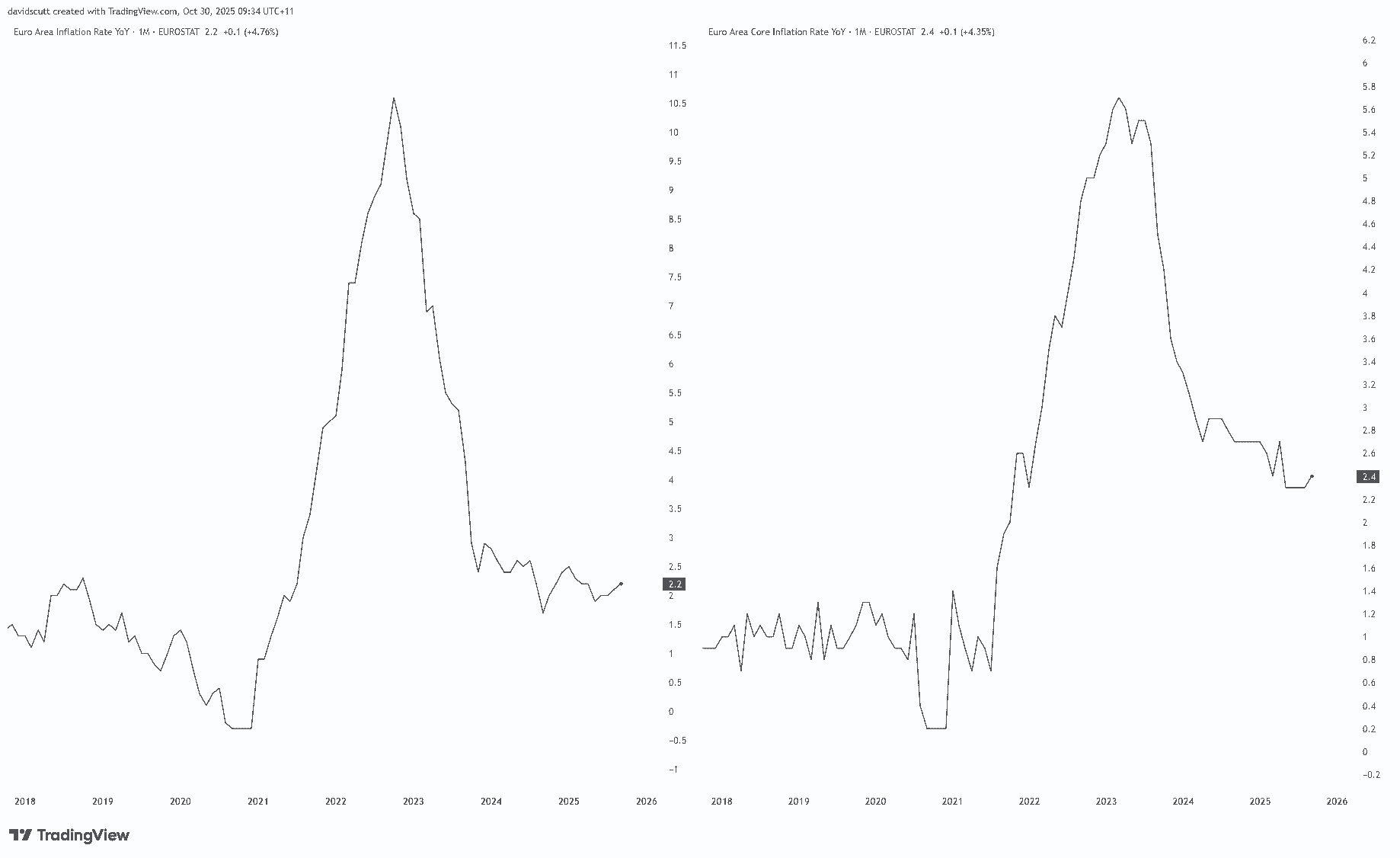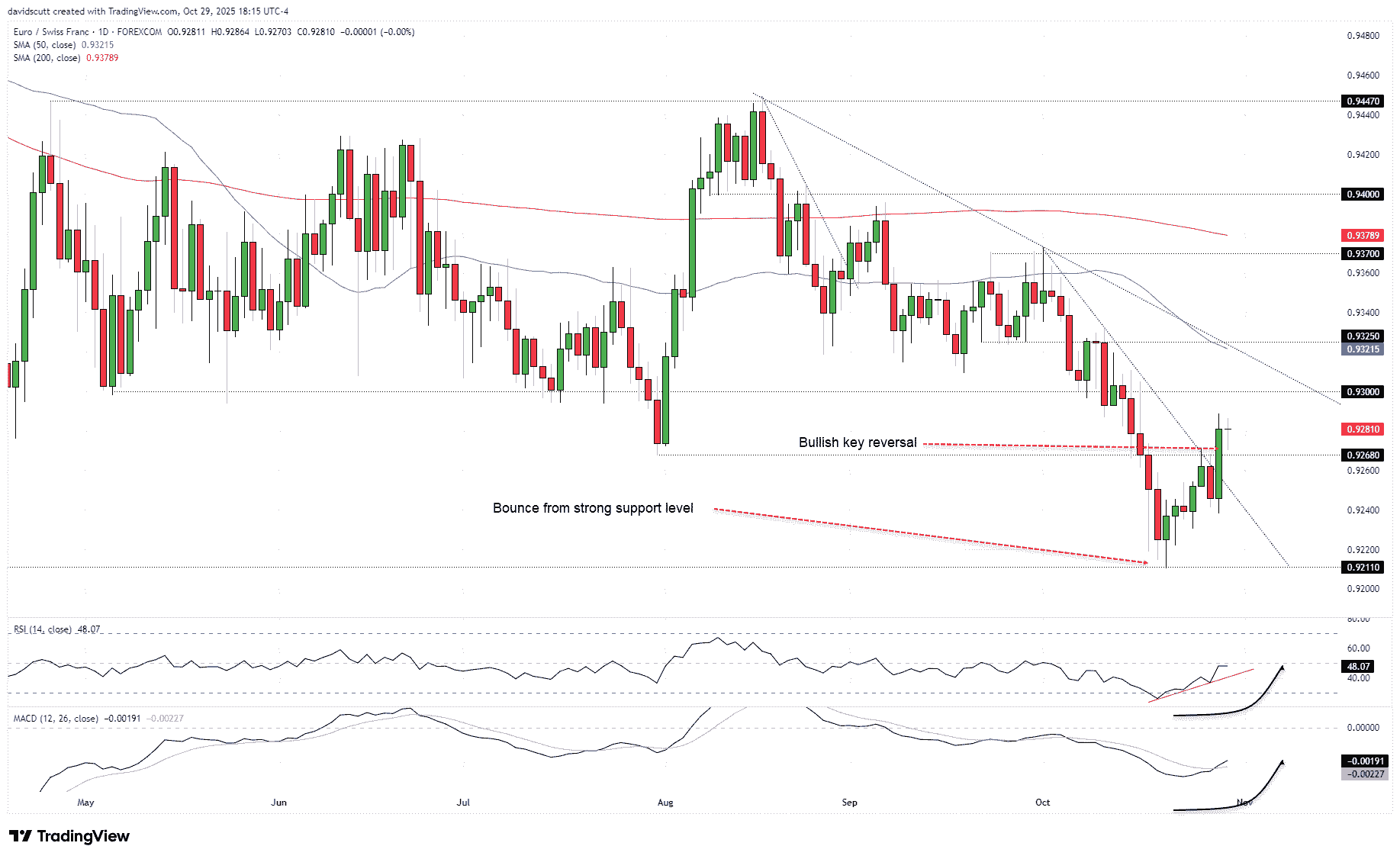SharkNinja shares soar 11% as third quarter results crush expectations
Markets are leaning dovish, so any hawkish ECB surprise could jolt EUR higher into the month-end.
- No new ECB forecasts at this meeting.
- Rates are seen on hold at 2%.
- Guidance may tilt hawkish relative to market pricing.
- EUR/USD, EUR/CHF setups covered.
EUR Outlook Summary
Out of this week’s central bank extravaganza, Thursday’s European Central Bank (ECB) policy decision looks the least likely to deliver fireworks. Economic data is holding up reasonably well, and with inflation back at target, rates are expected to remain unchanged for the foreseeable future.
With the FOMC meeting now behind us and only Apple and Amazon left to report among the tech titans, traders may soon be able to place more weight on price action rather than headlines when assessing potential setups—unless Donald Trump and Xi Jinping end up having one almighty spat when they meet later today in South Korea, of course.
Macro Backdrop Points to ECB Policy Inaction
Following hawkish rate cuts from the Bank of Canada and Federal Reserve on Wednesday, we’re nearing the end of this week’s central bank decision deluge, with only the Bank of Japan and ECB left among the majors. The latter is widely expected to leave its key deposit rate unchanged at 2% later today, but on balance, its guidance on the rates outlook may lean hawkish relative to current market pricing.
And why wouldn’t it, given the macro backdrop? Just look at recent trends in European data in the graphic below, as tracked by Citi’s economic surprise index. Sitting marginally in positive territory, it indicates the recent flow of economic data has generally surprised to the upside, showing no signs of a rapid deterioration that would warrant further policy stimulus.
Source: LSEG
Euro area inflation measures are also sitting slightly above target, with headline prices rising 2.2% over the year and the core measure a touch stronger at 2.4%, based on the latest data. Again, there’s nothing there to suggest a need to cut rates, even if that may become a risk longer term should euro strength start to weigh on economic activity and dampen import prices.
Source: TradingView
It’s little wonder markets see the ECB holding rates steady well into next year, with swaps pricing still marginally favouring 2% as the nadir for the deposit rate this cycle. While the flat swaps profile shown below creates the potential for the ECB to surprise with guidance—which would meaningfully influence the euro, given many think the easing cycle is done—the question is, if they did surprise, would it be more dovish or hawkish?
Source: Bloomberg
ECB Rate Guidance May Tilt Hawkish
Right now, given optimism towards international trade is arguably the highest it’s been this year, and considering the euro area’s reliance on offshore markets, I think it’s far more likely to be hawkish than dovish. That points to the skew in directional risks for the euro coming out of the ECB decision as slightly higher rather than lower, at least from a fundamental perspective. However, that depends on the pair in question.
EUR/USD Delivers Bearish Pattern

Source: TradingView
Looking at EUR/USD on the daily timeframe, the pair struggled to break above resistance at 1.1650 earlier this week, with bears eventually winning the day thanks to Jerome Powell’s assertion that a December rate cut from the Fed was “far from” a foregone conclusion. That remark helped deliver a big bearish bar on the daily, completing a three-candle evening star pattern in the process.
That points to near-term downside risks, although the pair has found buyers beneath 1.1600 recently, as was the case last week. Unless something big happens in Asia—either the Trump-Xi meeting or the Bank of Japan policy decision—EUR/USD is unlikely to stray too far from these levels during the session. The former is certainly a high-risk event, but given Trump’s mission to sign deals during his sweep across Asia, I suspect the end outcome will be a risk-positive one for markets.
On the downside, 1.1544 marks the double-bottom seen earlier this month, emphasising its significance. If it were to be broken, there’s not a lot of visible support until 1.1450 and 1.1400, although some bids may emerge at 1.1500. Looking above, 1.1650 remains the first level of interest, with the 50-day moving average located just above. They loom as potentially tough barriers for bulls. If the pair were to break and close above the latter, there’s not a lot of major levels found above until 1.1900.
While momentum indicators are providing marginally bearish signals, the overall message from the pancake trend in RSI (14) and MACD is neutral, putting far more emphasis on near-term price action to guide decision making.
EUR/CHF Still Grinding Higher

Source: TradingView
It may be the crosses where better setups can be found, including EUR/CHF. The bounce I was looking for from major support at .9211 has played out nicely, mirroring the price action seen on the last three occasions the pair tested or neared the level. Over recent days, we’ve seen the October downtrend taken out along with horizontal resistance at .9268. Adding to the constructive price action for longs, we just saw a bullish key reversal candle print on the daily chart on Wednesday, pointing to building upside risks.
.9268 screens as a decent level for fresh longs to be established, allowing for entry above with a stop below. .9300 comes across as an appropriate initial target, with the confluence of horizontal resistance, 50-day moving average and August downtrend around .9325 the next after that. If that zone were to be broken cleanly, .9370 resistance and the 200-day moving average are two levels likely to be targeted by bulls. If EUR/CHF were to reverse below .9268 and hold there, .9240 is a minor level of note, with .9211 a far tougher test for bears some 30 pips below.
Momentum indicators are shifting quickly from bearish to neutral, with RSI (14) trending higher near 50 while MACD has crossed the signal line from below while remaining in negative territory. The message is one of rapidly diminishing downside pressure, with current trends pointing to the risk it may soon flip bullish, favouring upside.
